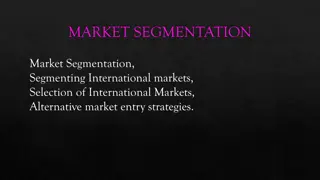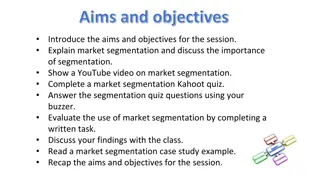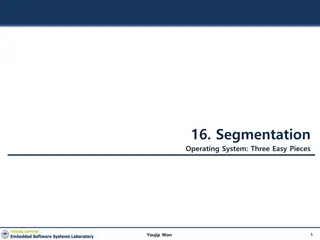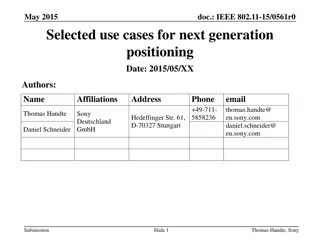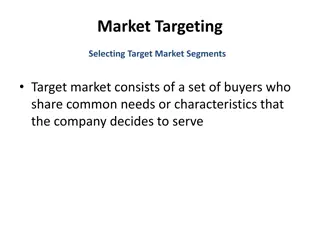
Strategic Marketing: Market Segmentation, Targeting, and Positioning
Learn about market segmentation in strategic marketing, where the market is divided into subsets of customers based on various criteria. Understand the importance, objectives, and reasons for developing market segmentation strategies.
Download Presentation

Please find below an Image/Link to download the presentation.
The content on the website is provided AS IS for your information and personal use only. It may not be sold, licensed, or shared on other websites without obtaining consent from the author. If you encounter any issues during the download, it is possible that the publisher has removed the file from their server.
You are allowed to download the files provided on this website for personal or commercial use, subject to the condition that they are used lawfully. All files are the property of their respective owners.
The content on the website is provided AS IS for your information and personal use only. It may not be sold, licensed, or shared on other websites without obtaining consent from the author.
E N D
Presentation Transcript
CLASS: M.COM(PREVIOUS) SEMESTER-2 SUBJECT: STRATEGIC MARKETING TOPIC: MARKET SEGMENTATION, TARGETING AND POSITIONING. PROF. RAJESH BALA ( ASSISTANT PROFESSOR) DEPARTMENT OF COMMERCE & MANAGEMENT IB PG COLLEGE, PANIPAT KURUKSHETRA UNIVERSITY, KURUKSHETRA
MARKET SEGMENTATION Introduction: Division of market into several segments is called market segmentation. This concept is based on the assumption that two buyers are not identical in all respect. They may differ on the basis of income, sex, age, education, profession, religion, social class and family, etc.
MARKET SEGMENTATION Definition: According to Phillip Kotler: Market segmentation is the subdividing of market into homogeneous subset of customers, where any subset may conceivably be selected as a market target to be reached with a distinct marketing mix.
Example: Suppose we divide the whole market into two parts: MARKET SEGMENTATION MALE FEMALE Suppose MALE segment is selected, which can further be segmented on the basis of Age: INFANT YOUNG ADULT OLD Suppose YOUNG Sub-Segment is selected, then further we can categorize it on the basis of Income: HIGH INCOME GROUP MIDDLE INCOME GROUP LOW INCOME GROUP So, It is concluded that our target customer are the Young Males with Middle Income Group and the process is called Market Segmentation.
Objectives of Market Segmentation: MARKET SEGMENTATION nature, tastes, habits, income, behavior, qualities and needs etc. Grouping of customer on the basis of their homogenous characteristics, such as To locate or identify the tastes, buying motives, needs, priorities and preference of the customer To determine marketing strategies, target and goals To make the activities of the firm customer-oriented. Customer orientation makes marketing segment an important pillar of the marketing concept To identify the areas or sectors where the customer may be created.
Reasons for development of Market Segmentation: MARKET SEGMENTATION Segmentation: Wiiliam J. Stanton has described the following reasons for development of Market 1. Customer Orientation 2. Technological Advancements 3. Use of the Cost-Reducing techniques 4. Increase in Purchasing power 5. Increase in Competition
Requirement/Criteria for effective segmentation: MARKET SEGMENTATION considered: For Effective Market Segmentation, the following requirements must be 1. Identifiable 2. Measurable 3. Accessible 4. Responsiveness 5. Significant 6. Substantiable.
Methods of Market Segmentation: MARKET SEGMENTATION differences, as under: Therefore, The market can be divided in different segments on the basis of such Each Buyer : A separate Market: It is based on the assumption that every buyer in himself is a market because of different necessities and preferences. Such Classification is possible for the goods whose buyers are limited. For example: Ships, Aircrafts, refineries, etc. Framing Broad Groups of Buyers: Under this, Customers with similar characteristics are grouped under one segment and each segment is treated as a separate market. Especially when the number of customers is large. For eg: Ladies wear, Children wear, Gents wear, etc.
Concept/Approaches to market segmentation: MARKET SEGMENTATION The marketeers adopt several approaches to segmenting a market: Approaches Product dffferentiation Markeingi Mass Marketing Target Marketing Market Segmentation Market Targeting Product Positioning
These approaches can be defined as follows: Mass Marketing: In this total market, It is considered as one-segment. Under mass-marketing, only one quality of product is produced and sold in market MARKET SEGMENTATION for all customers with the help of common marketing program. For eg: CocaCola. Product Differentiation Marketing: When Marketeer tries to provide different sizes, colours, shapes, features and qualities in his product as per the need and wants of customers of different segments. For eg: Maruti Udyog Limited manufactures Car in different models, colours and price range. Target Marketing: The target market is defined as a set of actual potential buyers of a product, service, or an idea. Target marketing helps the marketeer to correctly identify the markets: The groups of consumers for whom the product is designed. It has three steps: 1.Market Segmentation 2.Market Targeting 3. Product Positioning
Basis of Market Segmentation: MARKET SEGMENTATION
The most common and popular criteria basis or factors for market segmentation which are used by marketing managers are as follows: MARKET SEGMENTATION Geographic: Segmenting by country, region, city or other geographic basis. Demographic: Segmenting based on identifiable population characteristics, such as age, occupation, marital status and so on. Psychographic: This segmentation approach involves an understanding of a consumer s lifestyle, interests, and opinions. Behavioral: Segmenting the market based on their relationship with the product or the firm. Examples include: heavy or light users, brand loyal or brand switchers, and so on.
TARGETING Introduction: Targeting is the actual selection of the segment you want to serve. I t is the second stage of segmenting, Targeting and positioning.(STP) approach. Targeting is an act of evaluating and selecting one or few market segments that have been identified, the marketeer must choose the most attractive option for their marketing efforts.
Market Segmentation Strategies: MARKET SEGMENTATION
The three types of marketing strategies are as follows: MARKET SEGMENTATION customer characteristics. Alternatively, the cost of developing a separate marketing mix for separate segments may outweigh the potential gains of meeting customer needs more exactly. Under these circumstances a company will decide to develop a single marketing mix for the whole market. There is absence of segmentation. For eg: Salt, kerosene oil, etc. Differentiated marketing or multi-segment targeting: When market segmentation reveals several potential target segments that the company can serve profitably, specific marketing mixes can be developed to appeal to all or some of the segments. A differentiated marketing strategy exploits the differences between marketing segments by designing a specific marketing mix for each segment. Undifferentiated marketing strategy: There may be no strong differences in
The car market is most clearly segmented. There are segments for small cars, luxury cars, sports utility vehicles, etc. Most car makers like General Motors, Ford, Toyota, Honda and others offer cars for all the segments. Though Toyota MARKET SEGMENTATION entered the US market with small cars, it eventually chose to operate in most of the segments. Concentrated marketing strategy: Several segments may be identified but a company may not serve all of them. Some may be unattractive or out of line with the company s business strengths. A company may target just one segment with a single marketing mix. It understands the needs, and motives of the segment s customers and designs a specialized marketing mix. For eg: Lakme cosmetics for females, Johnson&Johnson products for babies.
POSITIONING Introduction: Positioning refers to the process by which marketeer try to create an image or an identity in the mind of their target market for its product, brand or an organization. The main objective of positioning is to convince customer to believe the marketeers offers are different in some way from its competitors on an important benefit sought by the market. For eg: Dell Company has a good position in the mind of customers for laptop.
Types of Positioning Strategies: MARKET SEGMENTATION Product attributes and benefits: Associating your brand/product with certain characteristics or with certain beneficial value There are several types of positioning strategies. A few examples are positioning by: Product price: Associating your brand/product with competitive pricing Product quality: Associating your brand/product with high quality Product use and application: Associating your brand/product with a specific use Competitors: Making consumers think that your brand/product is better than your competitors
How to Create an Effective Market Positioning Strategy?: To Create a positioning statement that will serve to identify your business and how you want the brand to be perceived by consumers, The steps are as follows: MARKET SEGMENTATION 1. Determine company uniqueness by comparing to competitors: Compare and contrast differences between your company and competitors to identify opportunities. Focus on your strengths and how they can achieve these opportunities. 2. Identify current market position: Identify your existing market position and how the new positioning will be beneficial in setting you apart from competitors. 3. Competitor positioning analysis: Identify the conditions of the marketplace and the amount of influence each competitor can place on each other. 4. Develop a positioning strategy: Through the preceding steps, you should achieve an understanding of what your company is, how your company is different from competitors, the conditions of the marketplace, opportunities in the marketplace, and how your company can position itself.
MARKET SEGMENTATION What is Market Repositioning?: Market repositioning is when a company changes its existing brand or product status in the marketplace. Repositioning is usually done due to declining performance or major shifts in the environment.





